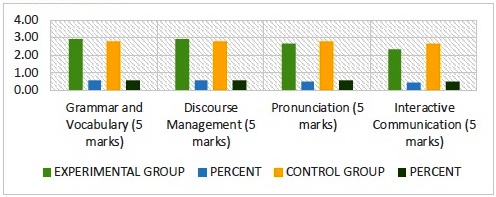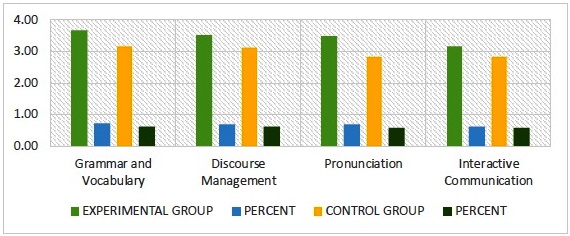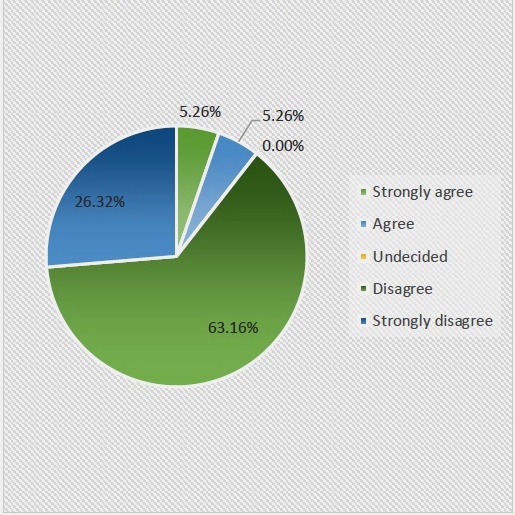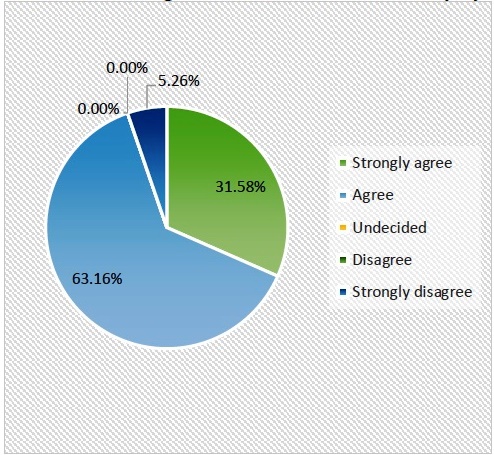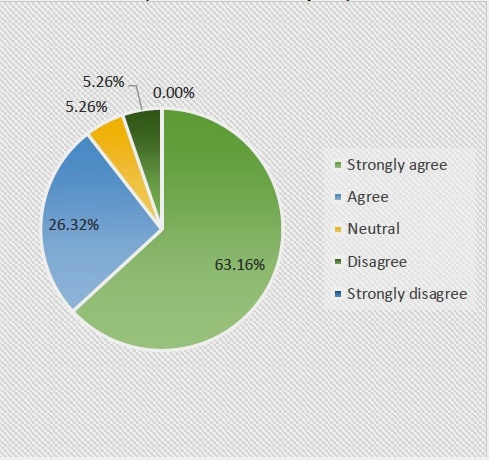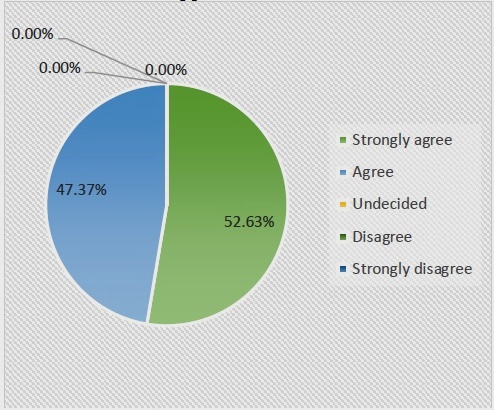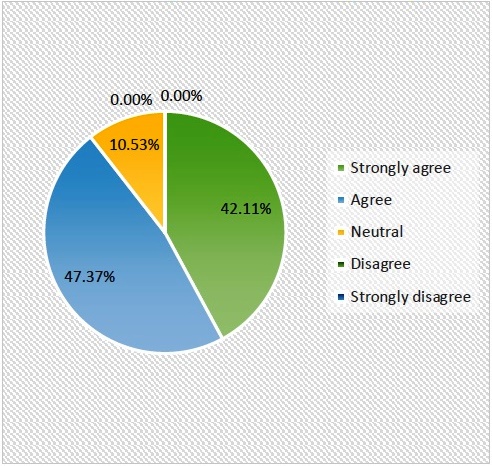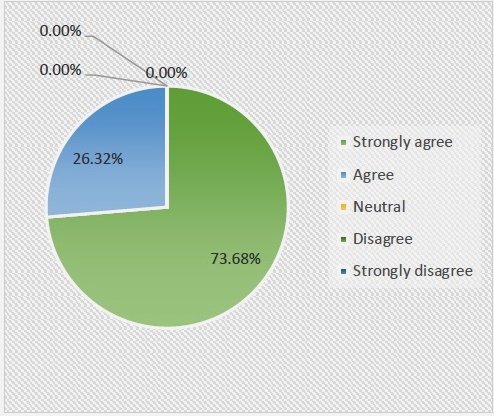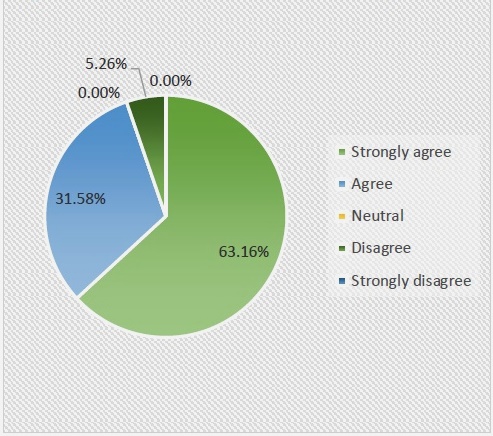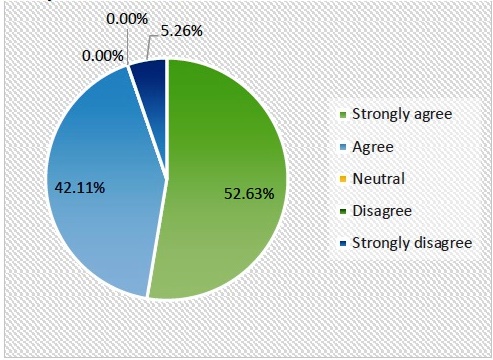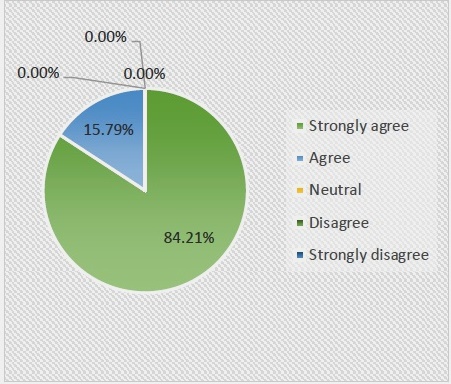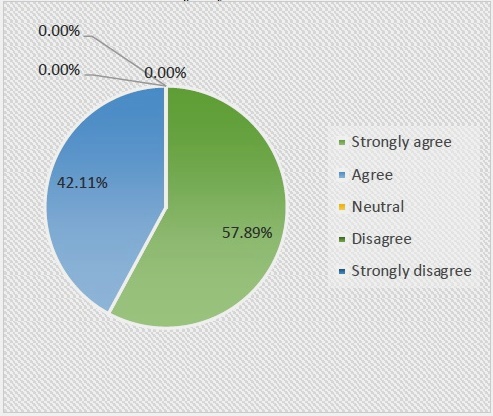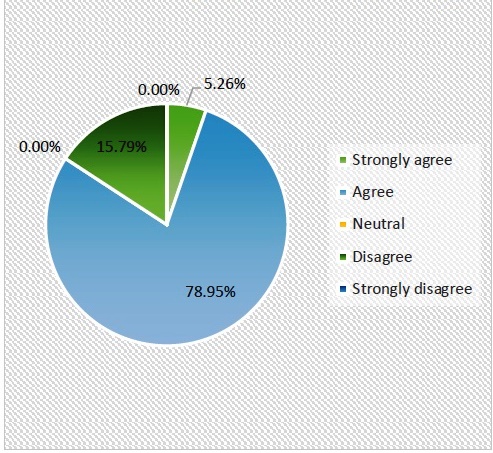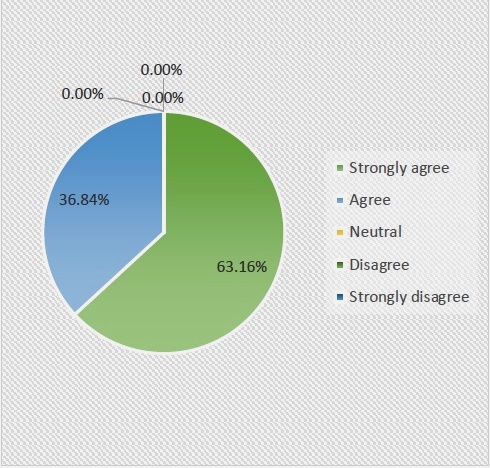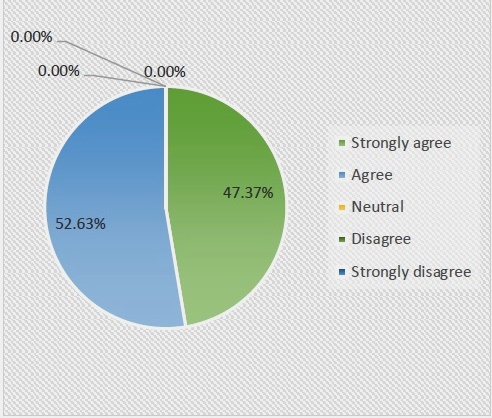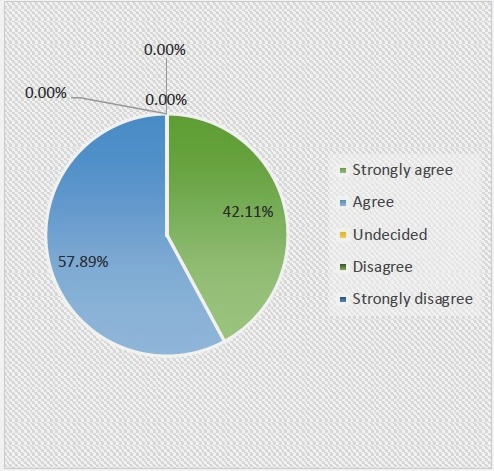INTRODUCTION
Globalization with technological association and digitalization have made social media an essential tool in the educational environment. Because of that, the use of social media to learn English has provided a variety of benefits to students in the academic field, such as communication and other resource exchanges among cybernauts (Pitaloka et al., 2021). As a result, social media is regarded as a complementary part of the teaching-learning process while acquiring the English language. Hence, speaking skills are a complicated talent that needs to be focused on performing students' oral production (Leong & Ahmadi, 2017). Because of that, the current research analyzes the influence of social media on EFL students' speaking skills in the second years of BGU at Unidad Educativa "12 de Noviembre" in Píllaro, Tungurahua Province.
To get the research's purpose, a survey with 15 questions was created in Google Forms to collect information about the students' preferences in using social media to foster the English language, particularly in performing linguistic competence. Additionally, the study applied a qualitative and quantitative approach, a quasi-experimental design, a field and bibliographical research work, and a T-test to validate the hypothesis. The participants were 37 students aged between 15 and 17 years old from the Mechanic specialty, parallels "A" and "B," which comprised the control and experimental groups.
The experimental group received 10 intervention sessions by applying social media tools with different activities inside and outside the computing lab. Social media like WhatsApp, Facebook, and YouTube were fundamental in this study to develop English skills and perform speaking ability. Besides, ASSURE methodology and ACA planning played a crucial part in the research to reach the proposed objectives and develop learners' activities successfully. On the other side, the control group continued traditional teaching during the whole process.
This research applied a pre-test and a post-test of speaking to the two groups. The instruments to collect data were a speaking test from the Center for Intensive English Studies of Florida State and a standardized speaking rubric from Cambridge B1, which determined the levels of grammar and vocabulary, discourse management, pronunciation, and interactive communication of each learner. As a result, according to the findings, it was evident that social media is a powerful resource for encouraging students to learn the English language and foster oral production in real life, considering their background, interests, and purposes.
METHODOLOGY
Location
The research was carried out in a public school called Unidad Educativa “12 de Noviembre”, located at the parish of San Miguelito, in Santiago de Pillaro city, province of Tungurahua. It has approximately 835 students.
Material and equipment
The resources used to achieve the goals were:
Research method
This study aims to investigate the influence of social media on EFL learners´ speaking skills in the second years of BGU at Unidad Educativa 12 de Noviembre in Pillaro, Tungurahua Province. A quasi-experimental design was used to intentionally manipulate the independent variable to perceive the effect that the dependent variable may impact. (Cabezas et al., 2018). Therefore, two groups of students were selected: one of 19 participants from Second Mechanic "B" as the intervention group using interactive techniques of learning and social media resources to improve their knowledge, especially their speaking skills. Consequently, the students in the experimental group developed critical thinking skills, fostered their creativity and collaborative learning, and communicated effectively to supervise oral development. In contrast, with 18 participants as control from Second Mechanic "A," this group received traditional classroom classes and worked according to the curriculum plan.
Furthermore, Ramos (2021) mentions that the quasi-experimental design uses two sub-levels in the independent variable: intervention in an experimental group and non-intervention in a control group. Besides that, the selection of the intervention groups is not random. Conversely, the dependent variable must be measured equally in both groups in the study.
Additionally, a quantitative approach was proposed to analyze the influence of social media on students' improvement of English-speaking skills. This method enables data collecting to support a hypothesis by applying numerical measurement and statistical analysis to define behavioral standards (Baena, 2017). In this connection, a qualitative approach was tried to collect information without numerical measurement to refine the research questions or generate new unknowns (Cabezas et al., 2018).
On another side, the model of instructional design ASSURE was used to plan this study based on student characteristics, the foundation of learning objectives, the choice of techniques and resources, the management of the learning environment, the implementation of strategies for students’ interaction, and the evaluation of technological resource achievement. Based on constructivism, this didactic style allows for developing methods based on student characteristics and encouraging active and engaged student learning (Lorenzo et al., 2016).
Eventually, an online survey was designed to collect information on students' preferences and the impact of social media on studying English as a foreign language. This research made use of Google Forms. Students received the link via WhatsApp. According to these outcomes, the research was valuable in evaluating its effect on the learning process and oral production for the participants of the second year of BGU at Unidad Educativa 12 de Noviembre in Píllaro.
Hypothesis
Alternative hypothesis (H1)
Social media influences on EFL learners' speaking skills from second-year BGU at Unidad Educativa 12 de Noviembre.
Population
The population of this study is the students from 15 to 17 years old belonging to the English proficiency level B1 according to the Common European Framework of Reference for Languages (CEFR). For this purpose, 37 second-year BGU students were selected among males and females from Unidad Educativa "12 de Noviembre" second term of the 2021-2022 school year. Within this population, the experimental group was designated as the second year "B," while the control group was the second year "A," which received traditional teaching. The purpose of the selection of the groups was to identify the influence of social media's use on EFL students' speaking skills through five weeks of intervention with the help of interactive techniques and the enrollment of social media in the Computing Laboratory.
Data collection
Procedure for data collection
The data was collected over five weeks, with ten sessions per group to train the group experiments using interactive techniques to develop English-speaking skills in students, which had different topics of study that allowed the students to perform the post-test. The sessions were split into five phases held in the computing lab. The resources used by the researcher to collect data and validate information were a pre-test, post-test, a speaking rubric from Cambridge, and an online survey.
Pre-test
Before the intervention, both control and intervention groups were given a face-to-face pre-speaking test to assess their previous oral production. This speaking test was 30 minutes long. A standardized test was adapted from the Center for Intensive English Studies of Florida State (Annex 4). This test consisted of two sections; the first was related to the active brain and practice questions. In contrast, a map provided the second section for guiding and answering three relevant aspects of the image that evaluate speaking skills, including critical thinking, creativity, reasoning, and effective communication. Moreover, a standardized rubric from the Cambridge assessment was regarded to determine the performance features of grammar and vocabulary, discourse management, pronunciation, and interactive communication, with the highest score of five and a lowest of zero points for each criterion to obtain a result of 20 points.
Post-test
After the five weeks of interaction, the same pre-test retrieved from the Center for Intensive English Studies of Florida State was applied to the two groups in face-to-face modality. They answered the same questions (Annex 2) to compare the students' learning in speaking skills and the development of competencies. The length of time of the test was 30 minutes.
Online survey
An online survey made it possible to collect data on the students' use of social media to study English as a second language in second-year BGU students at Unidad Educativa 12 de Noviembre. For this, a survey in Google Forms was used. The students received a link through WhatsApp to collect information on their level of compliance with the interactive techniques and technological resources used. The survey contained 15 questions on a Likert scale (Annex 6).
Data processing and analysis
The data collected was analyzed using SPSS Statistics v26. Within that aspect, the T-test was contemplated to examine the significant difference in the resulting grades of the students concerning the pre-test and post-test. Similarly, SPSS Statistics v26 was used to analyze students with the use of social media for the development of speaking skills.
Response variables or results
Among the expected results of the execution of the research is the English acquisition of speaking skills in the students, notably improving the dependent variable of EFL speaking ability with the use of interactive approaches.
The experimental group was developed over five weeks with 2 hours of application per week with ten hours during the intervention. The experimental group received five sessions with two hours of forty minutes each, where they also received activities inside and outside the classroom.
The applied activities allowed the student to work individually and in groups, guided by the teacher. Each session was divided into 5 phases, explained below:
Stage 1: Activities to ACTIVATE KNOWLEDGE/Building Background / Motivation
This is one of the most critical parts because it is the one that begins the class. Different materials, such as vocabulary, games, songs, and YouTube videos, were used here. As a result, it may or may not be relevant to the class topic to be taught or a motivating activity that connects the student's personal and academic experiences.
Stage 2: Activities to CONNECT background knowledge with new knowledge
The students acquired relevant information in this phase according to previous topics. Here, the resources used were from books and the Internet as handouts, slides with vocabulary or grammatical tips through Canva, and videos from YouTube. As a result, the students could understand the topic explained, which the teacher mediated. In addition, it is relevant to highlight that all the links were shared through WhatsApp or Facebook applications.
Stage 3: Practice Stage 1-Controlled
During this phase, the teacher supervised and helped students based on the sort of task that they must complete in class. The teacher monitored the development of activities or games using internet resources and social media sites to make the exercises more interactive and dynamic. As a result, the teacher paid attention to whether or not the learners had difficulty with the previously explained topics.
Stage 4: Practice Stage 2-Guided
The teacher facilitated this phase; however, it is frequently done in groups or pairs, making it more effective for the student’s performance in a cooperative and collaborative environment. They had a more significant opportunity to exchange information and reinforce their expertise through social media platforms. The activities could be graded or discussed in class.
Stage 5: Activities to AFFIRM knowledge
The most important task is to consolidate the students’ knowledge through an assessment or assignment that shows their understanding of the exercises and previous topics using social media such as WhatsApp, Facebook, and YouTube to develop their potential. Thus, the teacher determined the number of students who understood the class and who required feedback. Similarly, learners had the opportunity to reinforce their knowledge since they could learn from their mistakes and experiences while applying technological resources as innovative teaching and learning techniques.
RESULTS AND DISCUSSION
This chapter details and analyzes the results collected from the instruments used in the study: pre-test, post-test, rubric, and survey, with the control and experimental groups, for which frequency table and percentage graphs were developed using SPSS Statistics v26 to demonstrate the influence of social media on EFL students’ speaking skills in the second years of BGU at Unidad Educativa 12 de Noviembre in Pillaro, Tungurahua Province.
Pre-test
Table 3 Pre-test Results
| EXPERIMENTAL GROUP | PERCENT | CONTROL GROUP | PERCENT | DESIRABLE SCORE | |
|---|---|---|---|---|---|
| Grammar and Vocabulary | 2,89 | 58% | 2,78 | 56% | 5 |
| Discourse Management | 2,89 | 58% | 2,78 | 56% | 5 |
| Pronunciation | 2,68 | 54% | 2,78 | 56% | 5 |
| Interactive Communication | 2,32 | 46% | 2,67 | 53% | 5 |
| SCORE | 10,79 | 54% | 11,00 | 55% | 20 |
Note: Experimental and Control group
Source: Villalva, M. (2022).
Analysis and interpretation
For the development of the research, the instruments used for the pre-test were a standardized speaking test adapted from the Center for Intensive English Studies of Florida State and a speaking rubric from Cambridge B1, which measured the following parameters: Grammar and Vocabulary, Discourse Management, Pronunciation and Interactive Communication. Thus, the experimental and control groups received the same content and treatment. The students from the experimental group got a total score of 10.79/20, corresponding to 54%, and the control group received 11/20, corresponding to 55%. It means there is no significant result according to the scores. However, it is essential to highlight that these scores are before the application of the intervention sessions in the use of social media on EFL students' speaking skills.
Post-test
Table 4 Post-test Results
| EXPERIMENTAL GROUP | PERCENT | CONTROL GROUP | PERCENT | DESIRABLE SCORE | |
|---|---|---|---|---|---|
| Grammar and Vocabulary | 3,68 | 74% | 3,17 | 63% | 5 |
| Discourse Management | 3,53 | 71% | 3,11 | 62% | 5 |
| Pronunciation | 3,47 | 69% | 2,83 | 57% | 5 |
| Interactive Communication | 3,16 | 63% | 2,83 | 57% | 5 |
| SCORE | 13,84 | 69% | 11,94 | 60% | 20 |
Note: Experimental and Control group
Source: Villalva, M. (2022).
Analysis and interpretation
After five weeks of intervention, the experimental group was tested with the same standardized test from the Center for Intensive English Studies of Florida State and the speaking rubric from Cambridge. The purpose here was to analyze whether the resources, techniques, methodology, planning, and social media sessions have improved the students' speaking skills. It showed that the experimental group showed a significant improvement of 69%, an increase of 15%. On the other side, the control group only raised 60% of qualifications, 5% concerning the capabilities only with traditional instruction.
T-test
A T-test was applied to analyze the significant difference in the findings collected from the students in this study using a confidence level of 95%. The resulting data were the following:
Table 5 T-test of Post-test
| t | df | Sig. (2-tailed) | Mean Difference | Std. error difference | 95% confidence interval of the difference | |||
|---|---|---|---|---|---|---|---|---|
| Inferior | Superior | |||||||
| Post-test | Equal variances assumed | -2,592 | 35 | 0,014 | -1,89766 | 0,73226 | -3,38423 | -0,41109 |
| Equal variances assumed | -2,599 | 34,904 | 0,014 | -1,89766 | 0,73007 | -3,37993 | -0,41539 | |
Note: T-test
Source: Villalva, M. (2022).
Hypothesis verification
To give reliability to the outcomes, a t-test was applied to compare the data obtained with the control and experimental groups during the post-test, giving a two-tailed significance value of <0.05, indicating that this value presents a significant difference between the two studies groups. Thus, it is stated that the development of English-speaking ability results from social media applications. Therefore, this study's alternative hypothesis (H1) mentions that social media influences on EFL learners' speaking skills from second-year BGU at Unidad Educativa 12 de Noviembre is accepted. In contrast, the null hypothesis (Ho), which mentions that social media does not influence on EFL learners' speaking skills from second-year BGU at Unidad Educativa 12 de Noviembre, is rejected.
Survey
Table 6 Social media is used only for entertainment
| Scale | Frequency | % |
|---|---|---|
| Strongly agree | 1 | 5,26% |
| Agree | 1 | 5,26% |
| Undecided | 0 | 0,00% |
| Disagree | 12 | 63,16% |
| Strongly disagree | 5 | 26,32% |
| Total | 19 | 100,00% |
Note: Survey
Source: Villalva, M. (2022).
Analysis and interpretation
The graph shows that 12 students representing 63,16% disagree that social media is used only for entertainment, 5 students representing 26,32%, strongly disagree. Moreover, 1 student representing 5,26% strongly agree, and 1 student representing 5,26% agree.
This data proves that social media is used for more than just entertainment or personal issues. It is a vast information resource where students may seek assistance in education, politics, economics, health, sports, etc.
Table 7 Learners spend too much time using social media in their free time
| Scale | Frequency | % |
|---|---|---|
| Strongly agree | 8 | 42,11% |
| Agree | 10 | 52,63% |
| Undecided | 0 | 0,00% |
| Disagree | 1 | 5,26% |
| Strongly disagree | 0 | 0,00% |
| Total | 19 | 100% |
Note: Survey
Source: Villalva, M. (2022).
Analysis and interpretation
It is evident that 10 students representing 52, 63% agree that they spend too much time using social media in their free time, 8 students representing 42,11% strongly agree, and 1 student with 5,26% disagree.
With these outcomes, it is observed that learners spend most of their leisure time exploring various types of social media platforms that can serve as a means of communication through which education might enhance their English abilities.
Table 8 Social media is regarded as an essential source of information
| Scale | Frequency | % |
|---|---|---|
| Strongly agree | 6 | 31,58% |
| Agree | 12 | 63,16% |
| Undecided | 0 | 0,00% |
| Disagree | 0 | 0,00% |
| Strongly disagree | 1 | 5,26% |
| Total | 19 | 100% |
Note: Survey
Source: Villalva, M. (2022).
Analysis and interpretation
The data analysis illustrates that 12 students representing 63,16%, agree that social media is regarded as an essential source of information, 6 students representing 31,58%, strongly agree, and 1 student representing 5,26% strongly disagree.
With this result, students have particular preferences in using social media to research information about different topics according to their needs or interests because they can investigate many pages about a specific topic easily and comfortably.
Table 9 Social media let you communicate fastly and in real-time
| Scale | Frequency | % |
|---|---|---|
| Strongly agree | 12 | 63,16% |
| Agree | 5 | 26,32% |
| Neutral | 1 | 5,26% |
| Disagree | 1 | 5,26% |
| Strongly disagree | 0 | 0,00% |
| Total | 19 | 100% |
Note: Survey
Source: Villalva, M. (2022).
Analysis and interpretation
The statistical results point out that 12 students who represent 63, 16% strongly agree that social media let them communicate fastly and in real-time, 5 students who represent 26, 32% agree, 1 student who represents 5, 26% is neutral, and 1 student who represents 5, 26% disagree.
According to this analysis, students prefer using social media to communicate quickly without wasting time because these powerful resources are not limited. Because of that, they save time and money by communicating effectively, and students can easily share their thoughts or opinions, emphasizing oral production.
Table 10 Social media is a support in the academic área
| Scale | Frequency | % |
|---|---|---|
| Strongly agree | 10 | 52,63% |
| Agree | 9 | 47,37% |
| Undecided | 0 | 0,00% |
| Disagree | 0 | 0,00% |
| Strongly disagree | 0 | 0,00% |
| Total | 19 | 100% |
Note: Survey
Source: Villalva, M. (2022).
Analysis and interpretation
The illustration reveals that 10 students representing 52,63 %, strongly agree that social media is a support in the academic area, and 9 students representing 47,37%, agree.
The percentage of students looking for help on social media, especially in education-related topics, is high. Students feel motivated to search for helpful information which can reinforce and update their knowledge.
Table 11 Social media motivates students to reinforce their knowledge in topics of interest for them
| Scale | Frequency | % |
|---|---|---|
| Strongly agree | 8 | 42,11% |
| Agree | 9 | 47,37% |
| Neutral | 2 | 10,53% |
| Disagree | 0 | 0,00% |
| Strongly disagree | 0 | 0,00% |
| Total | 19 | 100% |
Note: Survey
Source: Villalva, M. (2022).
Analysis and interpretation
Of 19 students, 9 of them representing 47, 37% agree that social media motivates to reinforce their knowledge in topics of interest for them, and 8 students representing 42,11% strongly agree. On the other hand, 2 students representing 10,53% keep neutral.
Based on these findings, it is clear that students are more comfortable using social media since they find interactive tools to help them learn more. Furthermore, they are more interested in finding materials to help them in their academic studies such as videos, games, grammatical tips, active pages to perform the English language, etc.
Table 12 Teachers should incorporate more social media activities inside and outside the classrooms
| Scale | Frequency | % |
|---|---|---|
| Strongly agree | 14 | 73,68% |
| Agree | 5 | 26,32% |
| Neutral | 0 | 0,00% |
| Disagree | 0 | 0,00% |
| Strongly disagree | 0 | 0,00% |
| Total | 19 | 100% |
Note: Survey
Source: Villalva, M. (2022).
Analysis and interpretation
The descriptive statistics confirm that 14 students representing 73, 68%, strongly agree that teachers should incorporate more social media activities inside and outside the classrooms, and 5 students representing 26, 32%, agree.
This indicator reaffirms that social media greatly support the educational environment for developing students' communicative skills in the English language. Therefore, students consider the importance of social media for different tasks to improve their English, especially speaking skills that are not practiced more often.
Table 13 English classes should use social media applications to make them more dynamic
| Scale | Frequency | % |
|---|---|---|
| Strongly agree | 12 | 63,16% |
| Agree | 6 | 31,58% |
| Neutral | 0 | 0,00% |
| Disagree | 1 | 5,26% |
| Strongly disagree | 0 | 0,00% |
| Total | 19 | 100% |
Note: Survey
Source: Villalva, M. (2022).
Analysis and interpretation
Following the data analysis, 12 students representing 63,16 %, strongly agree that English classes should use social media applications to make them more dynamic, 6 students representing 31, 58 %, agree, and 1 student representing 5, 26%, disagree.
This data confirms that students like to use social media applications for educative topics because the English classes are more exciting and encourage them to learn funnily using different technologies. Because of that, English teachers should take advantage of the Computing laboratories to become more familiar and manage social media appropriately.
Table 14 The English skills (Listening, reading, speaking, and writing) can be fostered through the appropriate use of social media
| Scale | Frequency | % |
|---|---|---|
| Strongly agree | 10 | 52,63% |
| Agree | 8 | 42,11% |
| Neutral | 0 | 0,00% |
| Disagree | 0 | 0,00% |
| Strongly disagree | 1 | 5,26% |
| Total | 19 | 100% |
Note: Survey
Source: Villalva, M. (2022).
Analysis and interpretation
The graph highlights that 10 students representing 52,63%, strongly agree that the English language and its four skills can be fostered through the appropriate use of social media, 8 students representing 42,11% agree, and 1 student representing 5,26% strongly disagree.
This information concludes that the English language and social media are closely related to pushing education to a high-quality standard in which learners may enhance their English abilities by learning and having fun simultaneously.
Table 15 Social media has become well-known as an effective means of communication in the educational system during this pandemic situation
| Scale | Frequency | % |
|---|---|---|
| Strongly agree | 16 | 84,21% |
| Agree | 3 | 15,79% |
| Neutral | 0 | 0,00% |
| Disagree | 0 | 0,00% |
| Strongly disagree | 0 | 0,00% |
| Total | 19 | 100% |
Note: Survey
Source: Villalva, M. (2022).
Analysis and interpretation
According to the statistical results, 16 students representing 84,21%, strongly agree that social media has become well-known as an effective means of communication in the educational system during this pandemic situation, and 3 students representing 15,79 %, agree.
This data states that social media plays a leading role in effective communication, especially in the educational system, because teachers and students have to use it as a necessary educational resource. Thus, they realized how important is social media when facing an unexpected pandemic like Covid-19.
Table 16 The use of social media in class benefits you
| Scale | Frequency | % |
|---|---|---|
| Strongly agree | 11 | 57,89% |
| Agree | 8 | 42,11% |
| Neutral | 0 | 0,00% |
| Disagree | 0 | 0,00% |
| Strongly disagree | 0 | 0,00% |
| Total | 19 | 100% |
Note: Survey
Source: Villalva, M. (2022).
Analysis and interpretation
The pie chart shows that 11 students representing 57,89%, strongly agree that the use of social media in class benefits them, and 8 students representing 42,11%, agree.
Indeed, social media and social networks are immersed in all interactive environments, and the classroom is no exception, given the communication experienced easily and instantaneously (Cervantes, 2019). In addition, social media supports education, and students are more interested in learning.
Table 17 Social media encourages you to develop your English skills
| Scale | Frequency | % |
|---|---|---|
| Strongly agree | 1 | 5,26% |
| Agree | 15 | 78,95% |
| Neutral | 0 | 0,00% |
| Disagree | 3 | 15,79% |
| Strongly disagree | 0 | 0,00% |
| Total | 19 | 100% |
Note: Survey
Source: Villalva, M. (2022).
Analysis and interpretation
Of the surveyed participants, 15 students representing 78,95% agree that social media encourages them to develop their English skills, 3 students representing 15,79% disagree, and 1 student representing 5,26% strongly agree.
According to these statistics, learners prefer using social media to study English since many options catch their curiosity, and English seems entertaining.
Table 18 Teachers should use social media to improve the learners English-speaking skills
| Scale | Frequency | % |
|---|---|---|
| Strongly agree | 12 | 63,16% |
| Agree | 7 | 36,84% |
| Neutral | 0 | 0,00% |
| Disagree | 0 | 0,00% |
| Strongly disagree | 0 | 0,00% |
| Total | 19 | 100% |
Note: Survey
Source: Villalva, M. (2022).
Analysis and interpretation
Statistically, 12 students representing 63,16%, strongly agree that teachers should use social media to improve the learners English-speaking skills, and 7 students representing 36,84%, agree.
With this information, students suggest to teachers that it is necessary to incorporate social media activities in the classrooms because students feel more attracted to performing the English language but in particular the oral production because they feel self-confident and motivated when speaking in English. They do not feel stressed, insecure, or afraid of possible mistakes in their pronunciation.
Table 19 Learners can work cooperatively and collaboratively by using social media
| Scale | Frequency | % |
|---|---|---|
| Strongly agree | 9 | 47,37% |
| Agree | 10 | 52,63% |
| Neutral | 0 | 0,00% |
| Disagree | 0 | 0,00% |
| Strongly disagree | 0 | 0,00% |
| Total | 19 | 100% |
Note: Survey
Source: Villalva, M. (2022).
Analysis and interpretation
The graph indicates that 10 students representing 52,63%, agree that learners can work cooperatively and collaboratively by using social media, and 9 students representing 47,37%, strongly agree.
The data collected from this question highlights that students can share their experiences, mistakes, ideas, and opinions by working in teams using social media. They do not feel alone in the learning process or when they are in trouble.
Table 20 Students can become more self-critical, creative, and self-confident through social media
| Scale | Frequency | % |
|---|---|---|
| Strongly agree | 8 | 42,11% |
| Agree | 11 | 57,89% |
| Neutral | 0 | 0,00% |
| Disagree | 0 | 0,00% |
| Strongly disagree | 0 | 0,00% |
| Total | 19 | 100% |
Note: Survey
Source: Villalva, M. (2022).
Analysis and interpretation
In the last question, the statistical results reveal that 11 students representing 57,89%, agree that students can become more self-critical, creative, and self-confident through social media, and 8 students representing 42,11%, strongly agree.
This statistical evidence confirms that students regard social media as valuable instruments for discovering information, reinforcing their knowledge, and improving their English abilities since they learn by doing and performing their weaknesses. Additionally, through social media, learners can develop fluent speech without being intimidated or judged.
DISCUSSION
The findings acquired by various authors can be compared to the data gathered in the current study. In the same context, the author Anankulladetch (2017) denoted that social media allow a better understanding, engagement, and improvement of academic performance in students of English as a foreign language. Asserting the data collected in this study, students significantly improved the four evaluation criteria using social media to deliver educational topics according to the speaking rubric.
On the other hand, Mansor (2016) pointed out that social media generates a conducive environment for proper development, thus allowing an active collaboration between teachers and English learning facilities for students. Therefore, it contrasts with the previous data showing that social media in teaching English allows more accessible and interactive learning, motivating learners to develop verbal output through meaningful communication.
Thus, it is evident that social media can play a leading role in performing the English skills in students. As a result, this study highlights that social media encourages learners to use these tools to foster an education of quality.
CONCLUSIONS
This research has let us evidence how social media positively influences the development of the oral production of EFL learners. The results were the following:
● The advantages of incorporating social media in education, mainly in the educative community "12 de Noviembre" revealed that social media is not only for enjoyment. Furthermore, teachers and students used social media platforms as innovative and dynamic tools because they could all explore new alternatives to share educative links, look for additional information, watch videos, exchange documents, and make recordings in which learners feel self-confident and relaxed, and lastly update their technological skills. Additionally, learners pointed out how valuable social media was during these difficult times in the educational system due to the pandemic, as evidenced by the online survey findings.
On the other side, learners were encouraged to participate in interactive and funny activities individually, in pairs, or in groups, creating a stimulating, helpful, and didactic atmosphere in the teaching-learning process. Consequently, those were the results of applying the ASSURE methodology, the ACA planning, and social media intervention to the experimental group during the intervention sessions as a modern alternative to support education and enhance the English language.
● The most used social media for learning the English language in this research demonstrates that learners had particular preferences in using Facebook, YouTube, and WhatsApp to develop different activities inside and outside the classroom as more effective and pleasant teaching-learning strategies as a result of the lesson planning. Additionally, learners had plenty of knowledge on managing these trendy tools with security and confidence. In this sense, it is clear that the advancement in communication and technology positively perform English language skills. Furthermore, these helpful social media foment creativity, reasoning, and respect for the different points of view, making the English classes a fruitful experience while learning. In fact, according to the demands of this competitive society, these tools are closely connected to the real world for real situations and necessities where the English language plays an indispensable role in education.
● During this study, social media proved its helpfulness in EFL to enhance students’ speaking proficiency because the pupils from the experimental group were encouraged to use social media in the different activities developed inside and outside the computing laboratory to produce the verbal output. As a result, learners feel self-reliant, self-critical, and easygoing in expressing their ideas without thinking about possible mistakes, hesitations, or judgments from others and improving their speech. Learners performed their listening skills and comprehension by improving their speaking ability. Moreover, the intervention and control groups developed a Pre-test and a Post-test of speaking. The instruments were a test from the Center for Intensive English Studies of Florida State and a standardized rubric from Cambridge (B1).
The statistical results in the pre-test showed that the control group got 11% and the experimental group got 10.79%, with no meaningful significance over 20. In other words, the two groups began with identical features in terms of English language competence and speaking skill. On the other side, the statistical results in the post-test showed that the intervention group had a meaningful improvement of 15% in their oral production, highlighting progress in aspects of fluency, accuracy, grammar, vocabulary, and security according to the criteria from the speaking rubric. In contrast, the control group got a minimum improvement of only 5%.














